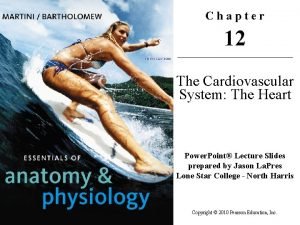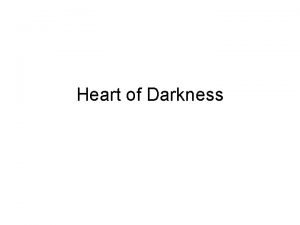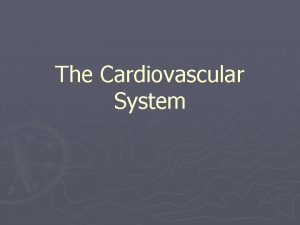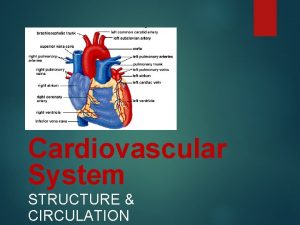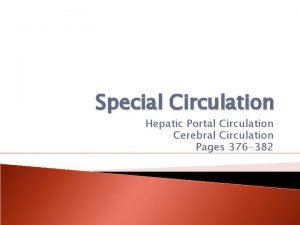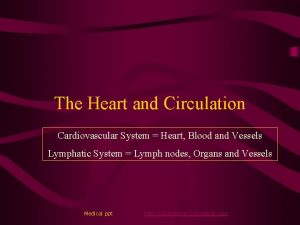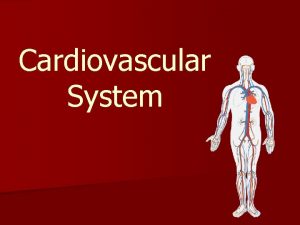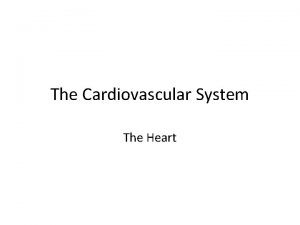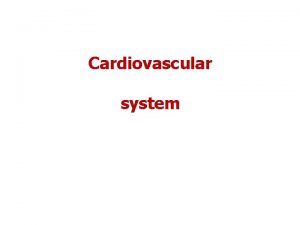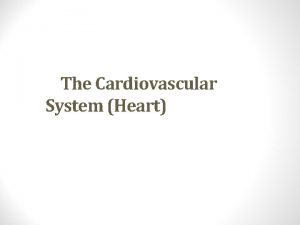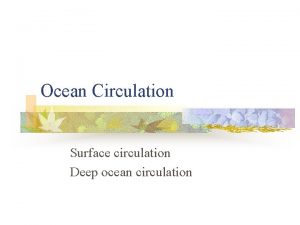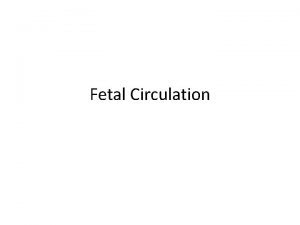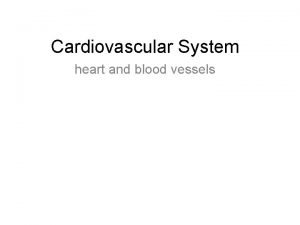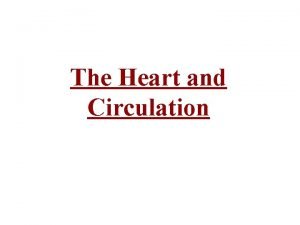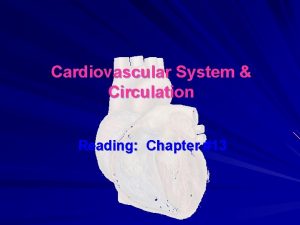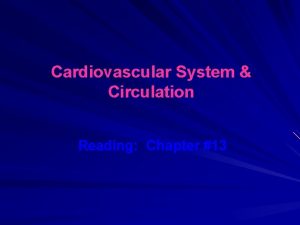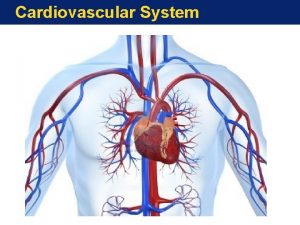The Cardiovascular System The Heart and Circulation Pages
























- Slides: 24

The Cardiovascular System The Heart and Circulation Pages 356 -363 © 2015 Pearson Education, Inc.

The Cardiovascular System � Includes the heart and the blood vessels � Functions: ◦ Deliver oxygen/nutrients to cells/tissues ◦ Remove carbon dioxide/waste products � Blood is the transport vehicle © 2015 Pearson Education, Inc.

The Heart � Location ◦ Thoracic cavity ◦ between the lungs within the inferior mediastinum (the central chamber of the thorax) � Orientation ◦ Pointed apex directed toward left hip ◦ Base points toward right shoulder � About the size of a human fist © 2015 Pearson Education, Inc.

Figure 11. 1 a Location of the heart within the thorax. Superior vena cava Aorta Pulmonary trunk Left lung Pericardium (cut) Diaphragm (a) Apex of heart

Figure 11. 1 b Location of the heart within the thorax. Midsternal line 2 nd rib Sternum Diaphragm (b)

Coverings of the Heart � The heart is enclosed by the pericardium � Pericardium—a double-walled (2 layered) sac ◦ Fibrous pericardium is loose and superficial ◦ Serous membrane is deep to the fibrous pericardium and composed of two layers: 1. Parietal pericardium: outside layer that lines the inner surface of the fibrous pericardium 2. Visceral pericardium: lies directly on heart; also known as the epicardium ◦ Serous fluid fills the space between the layers of pericardium �lubricates; prevents friction from the beating heart © 2015 Pearson Education, Inc.

Figure 11. 2 Heart wall and coverings. Pulmonary trunk Pericardium Myocardium Fibrous pericardium Parietal layer of serous pericardium Pericardial cavity Epicardium (visceral layer of serous pericardium) Heart wall Myocardium Endocardium Heart chamber

Walls of the Heart � Three layers comprise the walls of the heart: 1. Epicardium �Most superficial; connective tissue �(This is the visceral pericardium) 2. Myocardium �Middle layer- the one that contracts �Mostly cardiac muscle �Desmosomes hold cells together �gap junctions allow electrical wave to flow cell to cell 3. Endocardium �Inner layer known as endothelium �Endothelial cells are a layer of thin squamous cells with vascularity �A specialized type of epithelial cell © 2015 Pearson Education, Inc.

Figure 11. 2 Heart wall and coverings. Pulmonary trunk Pericardium Myocardium Fibrous pericardium Parietal layer of serous pericardium Pericardial cavity Epicardium (visceral layer of serous pericardium) Heart wall Myocardium Endocardium Heart chamber

Chambers of the Heart � Right and left side are separate pumps � Four chambers: § Atria -right and left (on top) § Receiving chambers § Ventricles -right and left (on bottom) § Discharging chambers © 2015 Pearson Education, Inc.

Figure 11. 3 b Gross anatomy of the heart. Left atrium Right ventricle (b) Frontal section showing interior chambers and valves. Left ventricle

Dividing structures of the heart � Interventricular septum ◦ Separates the two ventricles � Interatrial septum ◦ Separates the two atria © 2015 Pearson Education, Inc.

Figure 11. 3 b Gross anatomy of the heart. Superior vena cava Aorta Left pulmonary artery Right pulmonary artery Left atrium Right atrium Left pulmonary veins Right pulmonary veins Fossa ovalis Right atrioventricular valve (tricuspid valve) Right ventricle Chordae tendineae Pulmonary semilunar valve Left atrioventricular valve (bicuspid valve) Aortic semilunar valve Left ventricle Interventricular septum Inferior vena cava Myocardium Visceral pericardium (epicardium) (b) Frontal section showing interior chambers and valves.

Heart showing Atrial Septal Defect

Hypertrophic Cardiomyopathy (HCM)

Pulmonary Circulation � Oxygen-poor blood flows from the right side of the heart to the lungs � Oxygen-rich blood returns to the left side of the heart from the lungs © 2015 Pearson Education, Inc.

Systemic Circulation � Oxygen-rich blood flows from the left side of the heart (via the aorta) to body tissues � (oxygen is used at the cellular level; carbon dioxide is returned to circulation via veins for elimination from the body) � Oxygen-poor blood returns to the right side of the heart via the superior vena cava © 2015 Pearson Education, Inc.

Figure 11. 4 The systemic and pulmonary circulations. Capillary beds of lungs where gas exchange occurs Pulmonary Circuit Pulmonary arteries Pulmonary veins Aorta and branches Venae cavae Left atrium Right atrium Left ventricle Heart Right ventricle Systemic Circuit KEY: Oxygen-rich, CO 2 -poor blood Oxygen-poor, CO 2 -rich blood Capillary beds of all body tissues where gas exchange occurs

Heart Valves � Four valves: ◦ Atrioventricular (AV) valves—between atria and ventricles �Bicuspid (mitral) valve (left side of heart) �Tricuspid valve (right side of heart) ◦ Semilunar valves—between ventricle and artery �Pulmonary semilunar valve �Aortic semilunar valve © 2015 Pearson Education, Inc.


Function of Heart Valves � Allow for unidirectional flow; prevent backflow � Open/close in response to pressure changes in heart � Leaky valves are ok… to a degree § Valves that cannot close correctly cannot prevent backflow § Valves that are damaged (due to infection) require more forceful contraction § This leads to a weak heart and potential heart failure

Animations showing blood flow This link shows a summary of the process of blood flow: � http: //highered. mheducation. com/sites/0072495855/student_vi ew 0/chapter 22/animation__the_cardiac_cycle__quiz_2_. html � This link shows a step by step process of flow: � http: //www. sumanasinc. com/webcontent/anim ations/content/humanheart. html � This link shows a valve replacement!! Very cool � https: //www. youtube. com/watch? v=Cs. Idppya. PQ

Blood supply to the HEART � The heart has its own circulatory system § Coronary arteries—branch from the aorta to supply the heart muscle with oxygenated blood § Cardiac veins—drain the myocardium of blood and dump into the Coronary sinus (located posterior and inferior) � From the sinus, blood empties into the right atrium and is returned to pulmonary circulation for re-oxygenation at the lungs © 2015 Pearson Education, Inc.

Figure 11. 3 a Gross anatomy of the heart. Superior vena cava Right pulmonary artery Aortic arch Left pulmonary artery Pulmonary trunk Right pulmonary veins Left atrium Right coronary artery Anterior cardiac vein Right ventricle Left coronary artery Left ventricle Great cardiac vein Small cardiac vein Inferior vena cava Apex
 Single circulation and double circulation
Single circulation and double circulation Single circulation and double circulation
Single circulation and double circulation Blood air barrier cells
Blood air barrier cells Printed pages vs web pages
Printed pages vs web pages Crash course circulatory system
Crash course circulatory system Coronary circulation of heart
Coronary circulation of heart Heart of darkness pages
Heart of darkness pages Anatomy and physiology unit 7 cardiovascular system
Anatomy and physiology unit 7 cardiovascular system Cardiovascular system diseases and disorders chapter 8
Cardiovascular system diseases and disorders chapter 8 Blood vesel
Blood vesel What makes up the circulatory system
What makes up the circulatory system Rat cvs simulation
Rat cvs simulation Totally tubular dude
Totally tubular dude Chapter 5 the cardiovascular system labeling exercises
Chapter 5 the cardiovascular system labeling exercises Figure 11-7 veins labeled
Figure 11-7 veins labeled Chapter 11 the cardiovascular system figure 11-3
Chapter 11 the cardiovascular system figure 11-3 Lesson 11 cardiovascular system
Lesson 11 cardiovascular system Lesson 11 cardiovascular system
Lesson 11 cardiovascular system The circulatory system includes
The circulatory system includes Anatomy blood vessels
Anatomy blood vessels Introduction of cardiovascular system
Introduction of cardiovascular system Cardiovascular system
Cardiovascular system Chapter 13 cardiovascular system
Chapter 13 cardiovascular system Chapter 11 the cardiovascular system figure 11-2
Chapter 11 the cardiovascular system figure 11-2 The cardiovascular system includes the
The cardiovascular system includes the





